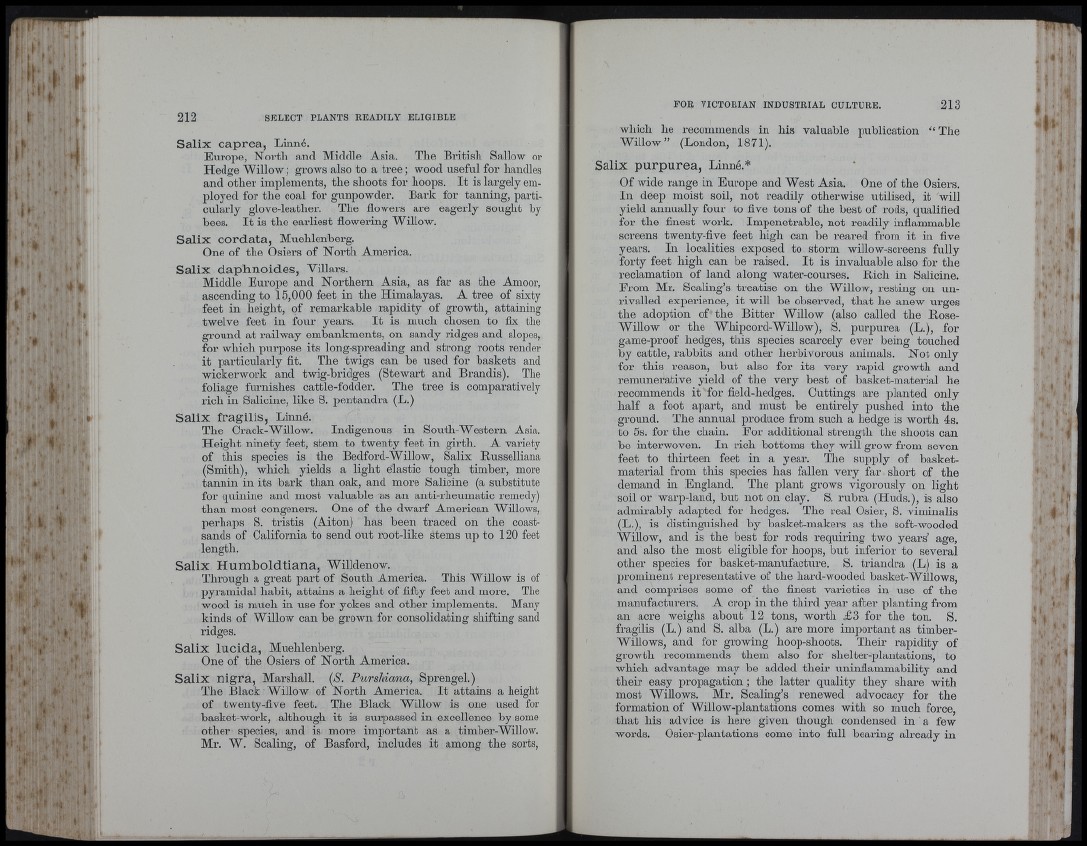
Salix caprea, Linné.
Europe, Nortli and Middle Asia. Tlie British Sallow or
Hedge Willow; grows also to a tree; wood useful for handles
and other implements, the shoots for hoops. I t is largely employed
for the coal for gunpowder. Bark for tanning, particularly
glove-leatlier. The flowers are eagerly sought by
bees. I t is the earliest flowering Willow.
Salix cordata, Muehlenberg.
One of the Osiers of North America.
Salix daphnoides, Yillars.
Middle Europe and Northern Asia, as far as tbe Amoor,
ascending to 15,000 feet in the Himalayas. A tree of sixty
feet in height, of remarkable rapidity of growth, attaining
twelve feet in four years. I t is much chosen to fix the
ground at railway embankments, on sandy ridges and slopes,
for which purpose its long-spreading and strong roots render
it particularly fit. The twigs can be used for baskets and
wickerwork and twig-bridges (Stewart and Brandis). The
foliage furnishes cattle-fodder. The tree is comparatively
rich in Salicine, like S. pentandra (L.)
Salix fragilis, Linné.
Tbe Crack-Willow. Indigenous in South-Western Asia.
Height ninety feet, stem to twenty feet in girth. A variety
of this species is the Bedford-Willow, Salix Russelliana
(Smith), which yields a light elastic tough timber, more
tannin in its bark than oak, and more Salicine (a substitute
for quinine and most valuable as an anti-rheumatic remedy)
than most congeners. One of the dwarf American Willows,
perhaps S. tristis (Aiton) lias been traced on the coast-
sands of California to send out root-like stems np to 120 feet
length.
Salix Humboldtiana, Willdenow.
Through a great part of South America. This Willow is of
pyramidal habit, attains a height of fifty feet and more. The
wood is much in use for yokes and other implements. Many
kinds of Willow can be grown for consolidating shifting sand
ridges.
Salix lucida, Muehlenberg.
One of the Osiers of North America.
Salix nigra, Marshall. (S. Purshimia, Sprengel.)
The Black Willow of North America. I t attains a height
of twenty-five feet. The Black Willow is one used for
basket-work, although it is surpassed in excellence by some
other species, and is more important as a timber-Willow.
Mr. W. Scaling, of Basford, includes it among tbe sorts,
which he recommends in his valuable publication “ The
Willow” (London, 1871).
Salix purpurea, Linné.*
Of wide range in Europe and West Asia. One of the Osiers.
In deep moist soil, not readily otherwise utilised, it will
yield annually four to five tons of the best of rods, qualified
for the finest work. Impenetrable, not readily inflammable
screens twenty-five feet liigh can be reared from it in five
years. In localities exposed to storm willow-screens fully
forty feet high can be raised. I t is invaluable also for the
reclamation of land along water-courses. Rich in Salicine.
Erom Mr. Scaling’s treatise on the Willow, resting on unrivalled
experience, it will be observed, th a t lie anew urges
the adoption of the Bitter Willow (also called the Rose-
Willow or the Whipcord-Willow), S. purpurea (L.), for
game-proof hedges, this species scarcely ever being touched
by cattle, rabbits and other herbivorous animals. Not only
for tliis reason, but also for its very rapid growth and
remunerative yield of the very best of basket-material he
recommends it for field-hedges. Cuttings are planted only
half a foot apart, and must be entirely pushed into the
ground. The annual produce from such a hedge is worth 4s.
to 5 s. for the chain. Eor additional strength the shoots can
be interwoven. In rich bottoms they will grow from seven
feet to thirteen feet in a year. The supply of basket-
material from this species has fallen very far short of the
demand in England. The plant grows vigorously on light
soil or warp-land, but not on clay. S. rubra (Huds.), is also
admirably adapted for hedges. The real Osier, S. viminalis
(L.), is distinguished by basket-makers as the soft-wooded
Willow, and is the best for rods requiring two years’ age,
and also the most eligible for hoops, but inferior to several
other species for basket-manufactnre. S. triandra (L) is a
prominent representative of the hard-wooded basket-Willows,
and comprises some of the finest varieties in use of the
manufacturers. A crop in the third year after planting from
an acre weighs about 12 tons, worth £3 for the ton. S.
fragilis (L.) and S. alba (L.) are more important as timber-
Willows, and for growing hoop-sboots. Their rapidity of
growth recommends them also for shelter-plantations, to
which advantage may be added tbeir uninflammability and
tlieir easy propagation; the latter quality they share with
most Willows. Mr. Scaling’s renewed advocacy for the
formation of Willow-plantations comes with so much force,
that his advice is here given though condensed in a few
words. Osier-plantations come into full bearing already in
f
■ i
iii